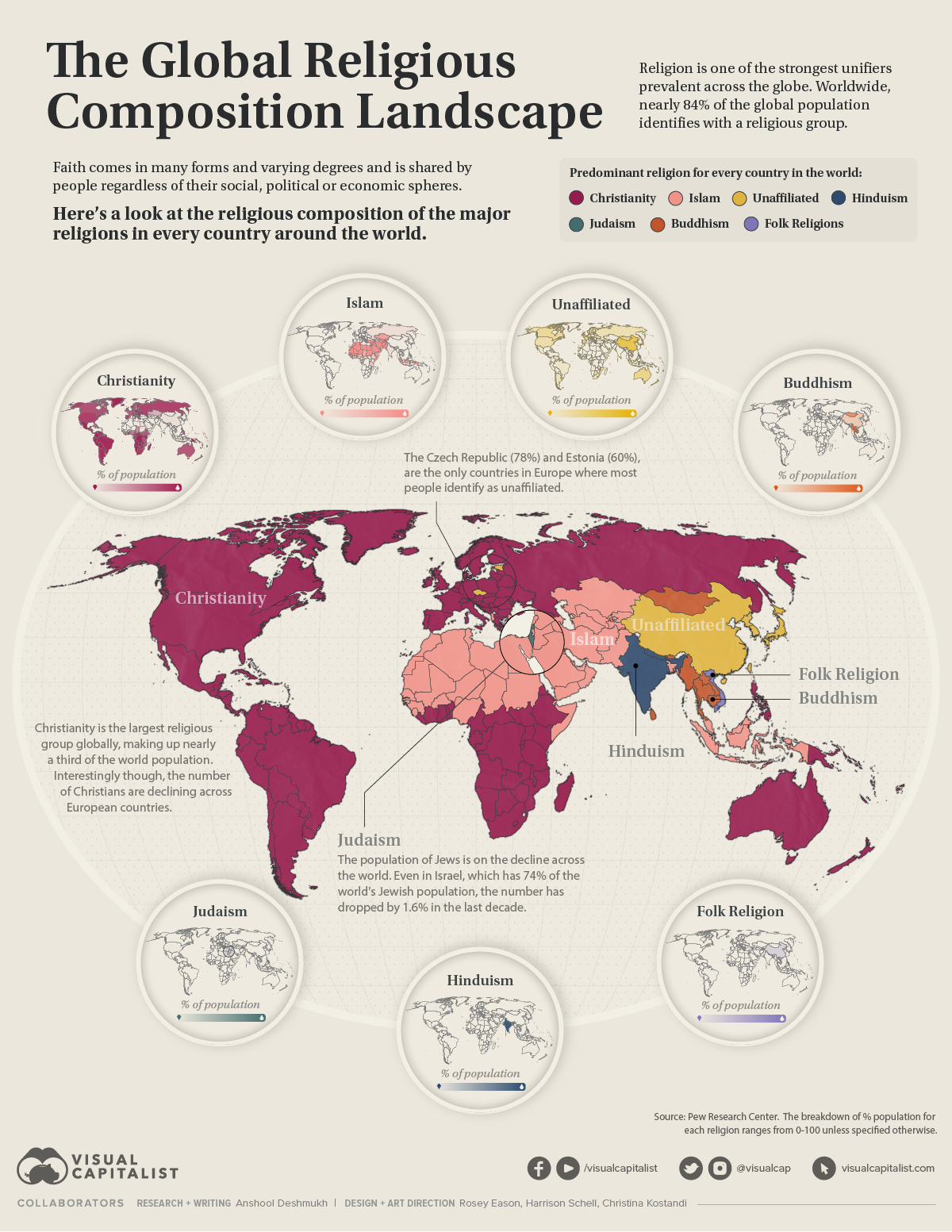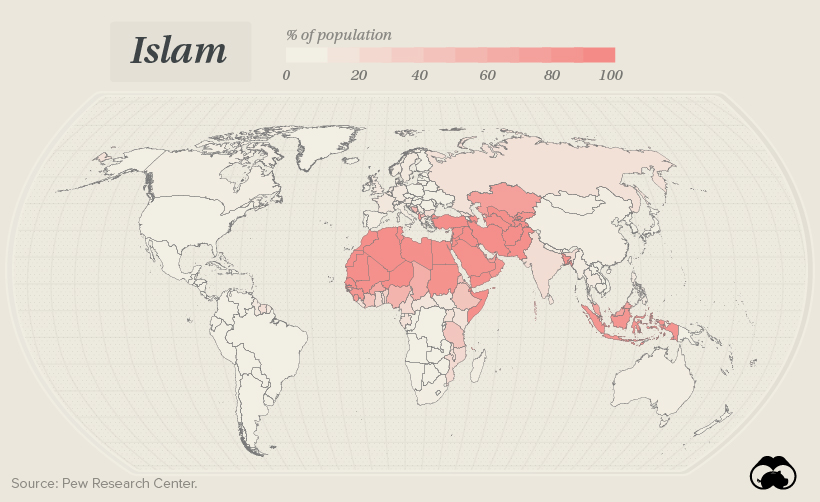
The Islamic world geographically and demographically
Dr. Moustafa El-Abdallah Al Kafry
The Islamic world geographically and demographically

Dr. Moustafa El-Abdallah Al Kafry
The Muslim world is one of the most important components of global divisions geographically and demographically, and its countries have many elements, the most important of which are: common religion, civilization, history, geography, political and economic interests, etc. [1]
The Muslim world is spread over four continents, but is mainly concentrated in Africaand Asia, where:
- On the African continent 26 countries, [2]
- In Asia, 27 countries, [3]
- Two countries in South America,
- One in Europe.
The Muslim world’s combined area is about 32 million square kilometres, nearly a quarter of the land area of about 149 million km2, and is surrounded by land borders estimated at 168,760 km. The largest country in the Muslim world is Kazakhstan, with an area of about 2,717,300 km2, and is ranked 11th in the world in terms of area, followed by Sudan (2,505,810 km2) and Algeria (2,381,740 km2). The smallest countries in the Muslim world are the Maldives (300 km2), Bahrain (620 km2) and Comoros (2,170 km2). [4]
Water covers a small part of the territory of the Muslim world, just over half a million square kilometres, and is run by the most important and longest rivers such as the Nile, the world’s longest rivers, Niger, Sindh, Zamberi, Tigris, Euphrates, Amo and Senegal.
The territory of Islamic countries comprises the world’s largest lakes such as: Caspian Sea 438,000 km2, Lake Victoria 83,000 km2, Lake Aral 63,000 km2, Lake Chad 16,000 km2, Dead Sea 1,050 km2.
Overlooking the most important seas, oceans and sea straits, the Islamic world has an estimated maritime border of 102,347 km, and its territory is home to the entrances to the Indian Ocean (the Strait of Malacca in the east between Malay and Sumatra, the Bab al-Mandab Strait in Yemen), the Mediterranean Sea (Egypt’s Suez Canal, and the Strait of Gibraltar in Morocco).
Statistics show the number, proportions and distribution of the world’s population by religion, with a world population of about 7,095 million, divided into groups by religious identity as follows: [5]
Christianity is the most widespread religion in the world, with more than 2.2 billion adherents, equivalent to 31.50 percent of the world’s total population.
Islam: It is the second most followed religion in the world, with an estimated 1.6 billion Muslims, or 23.20 percent of the world’s total population.

Hinduism: More than 1 billion people, or 15 percent of the world’s population, the vast majority of whom live in India.
Buddhism: One of the world’s major religions, with an estimated 500 million followers, or 6.77 percent of the world’s total population, more than half of them live in China.
Judaism: It is the oldest religion among the heavenly religions, and the number of Jews is estimated at 15 million, equivalent to (0.02%) of the world’s total population, and their largest concentration in occupied Palestine.
National doctrines: religions associated with tribe or race, with approximately 228 million followers of these positive doctrines, equivalent to (6%) of the world’s population.
non-religious: They are the ones who do not believe in religions and atheists, who make up 850 million of the peoples of the earth, equivalent to (14%) of the world’s total population.
Other religions: There are followers of other religions such as Baha’i, Taoism, Sikhism and many more.
The most populous Muslim countries are Indonesia (about 225 million), followed by Pakistan (about 142 million) and Bangladesh (about 129 million). The total population of these three countries accounts for 36% of the total population of the Muslim world. The fewest Muslim countries are the Maldives (about 301,000), followed by Brunei (about 336,000) and Suriname (about 431,000).
By expanding the Muslim world’s population on continents, they are more concentrated in Asia, where they number about 852 million, and then in Africa, numbering about 438 million. Of the world’s 40 most populous countries, 10 are Muslims, including Indonesia, in fourth place. Pakistan – ranked seventh. Nigeria – 10th place.
In fact, at the beginning of the 21st century, the Muslim population reached about 2 billion, about 65% of whom live in Muslim countries, and the rest reside in non-Muslim countries as minorities, or in countries that can be considered Islamic but have not yet joined the OIC, such as Bosnia and Herzegovina, or in countries that do not consider themselves Islamic, even though Muslims make up a high proportion of the population, such as Eritrea and Ethiopia. About 37% of the Muslim world’s population lives below the poverty line, equivalent to nearly 504 million people, and about 39% of the world’s poor.
Dr. Moustafa El-Abdallah Al Kafry
Faculty of Economics – Damascus University
[1] – Al Jazeera Net Thursday, September 4, 2001.
[2] – Uganda, Benin, Burkina Faso, Chad, Tunisia, Algeria, Comoros, Djibouti, Senegal, Sudan, Sierra Leone, Somalia, Togo, Gabon, Gambia, Guinea, Guinea-Bissau, Cameroon, Libya, Mali, Egypt, Morocco, Mauritania, Mozambique, Niger and Nigeria.
[3] – Azerbaijan, Jordan, Uzbekistan, Afghanistan, United Arab Emirates, Indonesia, Iran, Pakistan, Bahrain, Brunei, Bangladesh, Turkey, Turkmenistan, Saudi Arabia, Syria, Tajikistan, Iraq, Oman, Palestine, Kyrgyzstan, Qatar, Kazakhstan, Kuwait, Lebanon, Maldives, Malaysia and Yemen.
[4] – The figures here concern the 56 OIC member states.
[5] The number of Muslims and Christians in the world,
